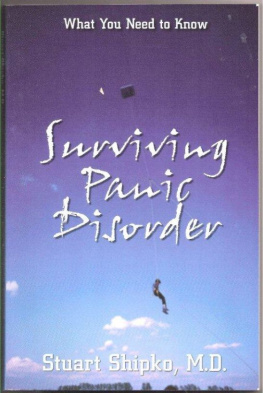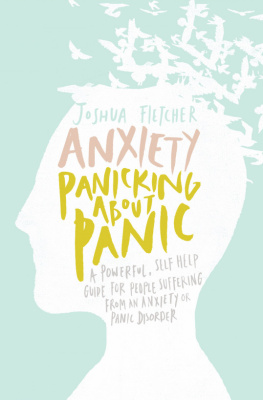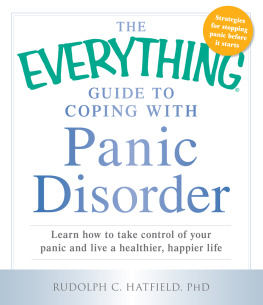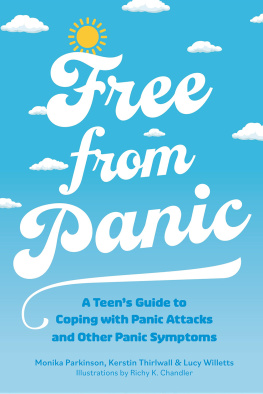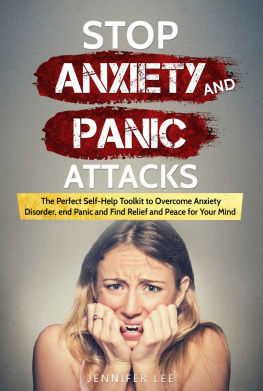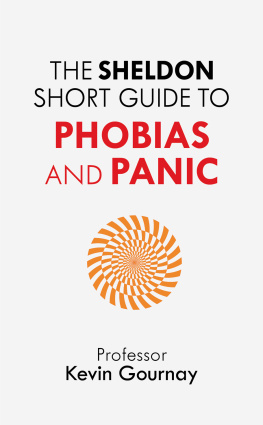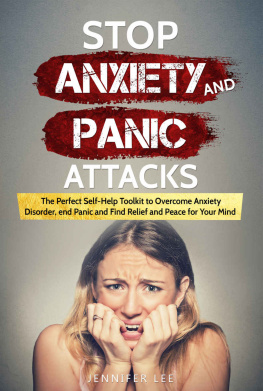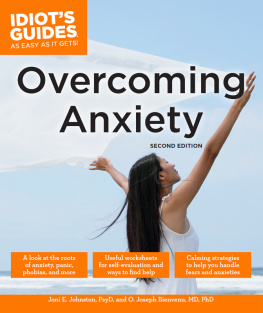Understanding Panic and Other Anxiety Disorders
Understanding Health and Sickness Series
Miriam Bloom, Ph.D.
General Editor
Understanding Panic and Other Anxiety Disorders
Benjamin A. Root

www.upress.state.ms.us
Copyright 2000 by University Press of Mississippi
All rights reserved
Manufactured in the United States of America
08 07 06 05 04 03 02 01 00 4 3 2 1

Illustrations by Regan Causey Tuder.
Library of Congress Cataloging-in-Publication Data
Root, Benjamin A.
Understanding panic and other anxiety disorders / Benjamin A.
Root
p. cm.(Understanding health and sickness series)
Includes index.
ISBN 1-57806-244-6 (cloth : alk. paper)ISBN 1-57806-245-4
(pbk. : alk. paper)
1. Panic disorders. 2. Anxiety. I. Title. II. Series.
RC535.R66 2000
616.85233dc21 00-021977
British Library Cataloging-in-Publication Data available
A man who fears suffering is already suffering from what he fears.
Michel de Montaigne
Contents
Introduction
Just over two decades ago, the idea of an emotional disturbance called panic disorder was officially introduced into common discussion among psychiatrists. Since that time much research, revision, and dissemination of knowledge have been undertaken regarding a group of disorders that are now fairly well recognized. Diverse studies indicate that 1.5 to 3.5 percent of the population experience panic disorder at some point in their lives, and many other people are afflicted with related disorders, such as social phobia, generalized anxiety disorder, depression, bipolar disorder, posttraumatic stress disorder, and specific phobia.
Its estimated that in the United States somewhere between three and six million people are affected by panic disorder. Although cultural differences allow for a variety of symptom patterns, the incidence of the disorder doesnt vary much according to social class or race. Women get panic disorder about twice as often as men. The disorder tends to make its initial appearance when a person is a young adult, but it can occur for the first time at any age. It is believed that about 70 to 90 percent of patients suffering from panic disorder will show significant improvement with appropriate treatment.
Symptoms of panic disorder were generally underreported and underrecognized by persons in the medical profession until fairly recently. Many people who were suffering sought help in emergency rooms and doctors offices, undergoing all manner of general examinations and laboratory tests to rule out various medical conditions. Frequently, nothing could be discovered to explain the difficulties, with the result that people were dismissed without adequate treatment. (Part of the problem in diagnosing panic disorder is that its symptoms mimic those of other, nonpsychiatric, conditions.) In fact, not much in the way of pharmacological treatment was available for this disorder until the last two decades, but in recent years a number of medications have appeared on the market to the benefit of those suffering from this often disabling affliction.
This book is designed for people who are interested in learning about panic disorder and related syndromes. I begin by describing the symptoms of panic disorder, discussing related conditions, and explaining panic attacks and the gradual refinement of our understanding of them. Next comes a review of the prevalence of the disorder and what researchers believe causes it, followed by a look at treatments. The book ends with a chapter on recent research.
Since no book can take the place of the individual attention provided by a doctor, I urge anyone who may be suffering from a psychiatric problem to seek help from a psychiatrist without delay.
Understanding Panic and Other Anxiety Disorders
1. The Nature of Panic Disorder
Emergency room doctors have always puzzled over the symptoms presented by patients, but the cases of those suffering from the anxiety disorders have been especially perplexing. Persons affected by panic attacks, in addition to experiencing profound fear and feelings of discomfort, usually have symptoms that could be cardiac, respiratory, neurological, or endocrinological. Appearing without any clear-cut precipitating factors, these episodes occur unexpectedly and repeatedly, so that patients usually end up seeing numerous specialists in an attempt to rule out a variety of general medical disorders.
The terms used to describe psychiatric disorders have changed over the years. During the American Civil War, Dr. Jacob Mendes DaCosta described finding in soldiers what he believed to be a cardiovascular disorder involving chest pains and palpitations of the heart, but, as it turned out, actual heart disease was not usually present. This syndrome became known as neurocirculatory asthenia and was also called effort syndrome, cardiac neurosis, soldiers heart, and DaCostas syndrome. It was often associated with the emotional and physical trauma of war.
Sigmund Freud used the term anxiety neurosis to describe a variety of anxiety-related symptoms, some taking the form of chronic, persistent anxiety and others characterized by sudden onslaughts of anxiety, a pattern to which we would probably apply the term panic attack. Freuds theories went through several stages of development, and a later one involved the idea that anxiety came from the threat posed by unacceptable libidinal wishes finding their way into the conscious mind. Partly as a result of the biological turn that psychiatry has taken, many mental health professionals have come to regard Freuds theories as obsolete, but he was a keen observer who, after all, felt that biology is destiny.
During and between the twentieth centurys two world wars, people with symptoms of panic disorder gradually came to be treated less frequently by those in the field of internal medicine and more often by psychiatrists. Observers of psychiatric disorders had early on distinguished between what we now know as panic disorder and agoraphobia, but, in spite of such historical observations, for many years agoraphobia was regarded as just another phobia without any special relation to panic disorder.
The central characteristic of panic disorder is that of having distinct episodes of intense anxiety, which develop abruptly and seemingly lack an adequate precipitating factor. These episodes tend to reach maximum intensity over a period of a few minutes and last for an unpredictable period of time. The notion of an adequate precipitating event is important, since the sufferers inevitably get the impression that certain situations contribute to the onset of an attack, so that they frequently start limiting activities in order to keep out of emotional harms way. Those who have had panic attacks report that they have never had any experience quite so terrifying. Frequently, however, they seem at a loss as to how to express the exact emotional ingredients. It is apparently difficult for someone who has never had such an attack to understand the impact. (It is sometimes helpful for doctors to talk to patients who only have episodes of increased anxiety in order to be able to differentiate these from genuine panic attacks.)
Another of the hallmarks of panic disorder is a persistent worry that a panic attack may occur, and this unpredictability typically causes additional consternation to those affected. Some people may worry excessively about their health, since they feel that something is really wrong, or they may become preoccupied with modifying their behavior in an effort to guarantee that a panic attack wont happen. Those with simple generalized anxiety disorder dont show that degree of interepisodic dread of recurring attacks, and neither do people who have occasional panic attacks that fall short of the full-blown syndrome.
Next page

